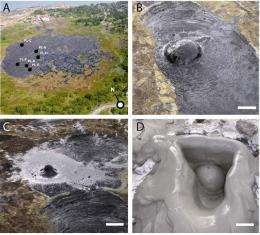April 21, 2010 report
Microbes found in natural asphalt lake

(PhysOrg.com) -- A lake of natural hot liquid asphalt in Trinidad and Tobago has been found to be teeming with microbes despite the toxic environment. The lake, aptly named Pitch Lake (since pitch is the old name for tar), is the nearest analog so far discovered to the seas of hydrocarbon on Saturn's moon, Titan, and raises the question of whether or not water should be considered as necessary for life.
Pitch Lake, located near La Brea in southwest Trinidad, covers an area of almost 40 hectares (100 acres), is around 75 meters deep, and is the largest surface reservoir of liquid asphalt in the world, supplying asphalt for roads on the east coast of the US. The temperatures of the liquid range from 30 to 55°C, and a hydrocarbon mix of methane, propane and ethane constantly bubbles up from the liquid. Isotope studies of the gas bubbles suggest they are produced by microbial activity.
Researchers led by Washington State University astrobiologist Dr Dirk Schulze-Makuch found the Caribbean island lake is full of living organisms, despite the extremely toxic environment, and despite it having no oxygen and almost no water. The population levels reported by the researchers were 1-10 million single-celled organisms per gram of the foul-smelling liquid. Gene sequencing of the microbes showed many kinds were present, such as bacteria and archea, which are single-celled organisms lacking a nucleus. Around thirty percent of the species were previously unknown.
Dr Schulze-Makuch said some of the microbes lived on sulfur, iron, or methane and other hydrocarbons, and some even breathed out metals. Schulze-Makuch said the microbes were distinctly different from those found in the Los Angeles LaBrea tar pits and other natural pitch seeps, and the only similar life forms ever found were in samples of hydrocarbons taken from sub-sea oil wells.
The researchers were most excited by the implications their discovery may have for the possible presence of life on Titan. The Saturnian moon has all the necessary elements for life, except that its seas are filled with methane instead of water, but the asphalt lake microbes survive well with almost no water, and other microbes have been found that create their own water by breaking down hydrocarbons. Dr Schulze-Makuch stresses, however, that life surviving in such toxic environments and arising in them in the first place are very different propositions. He also admitted that it is possible the microbes could have lived in minute reservoirs of water trapped within the asphalt.
The findings may mean that NASA’s motto of “follow the water” in its search for extraterrestrial life forms could lead to missing life existing where there is far less water than conventionally thought to be necessary.
More information: Microbial Life in a Liquid Asphalt Desert, Dirk Schulze-Makuch, et al., Arxiv, arxiv.org/abs/1004.2047
© 2010 PhysOrg.com

















